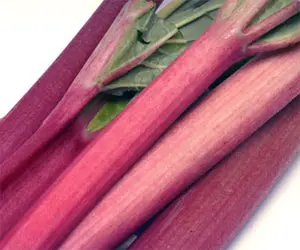
In spring, rhubarb successfully takes the place of berries and fruits. This highly nutritious plant has been known for over five thousand years, initially recognized in the East for its medicinal properties. It is widely cultivated in Western Europe, where it thrives in large fields. Here, we grow it primarily for its juicy stalks, which are used as a dietary food source. Fresh rhubarb stalks are rich in carotene (provitamin A), ascorbic acid, and vitamins B1, B2, and PP1, as well as essential minerals like phosphorus, magnesium, calcium, and potassium. They also contain pectin, sugars, and organic acids, including malic and citric acids, with a small amount of oxalic acid. In the spring, young stalks are predominantly high in citric acid, which later shifts to malic acid, while oxalic acid develops in the summer and fall. Thus, the most beneficial rhubarb is available in spring, from mid-April to June.
Rhubarb can be used to make compotes, jellies, jams, and fillings for pastries and cakes. It can also be added to vegetable soups and borscht (as a substitute for sorrel). Young leaves can be used in place of cabbage for making stuffed cabbage rolls. Additionally, juice from rhubarb can be fermented into wine.
This plant propagates by dividing the root clumps or, more commonly, by seedlings grown from seeds in open ground or greenhouses. It is planted in the spring with a spacing of 28-40 inches between rows and 28-40 inches between plants. Rhubarb can thrive in one spot for 15-20 years, so it’s essential to regularly apply sufficient organic and mineral fertilizers.
Stalks are harvested—one-third of the plant—during the second year from early spring to mid-summer. One hectare can yield 250-300 quintals of edible raw material. Flowering stems are removed to prevent weakening the plants.
The best variety of rhubarb is Victoria.
Juicy stalks can also be harvested in winter. To achieve this, the roots are dug up in the fall and kept in the garden, covered with peat or soil, until mid-January. They are then transferred to a greenhouse and planted in boxes or pots that can be placed on a windowsill. In 25-30 days, you can enjoy fresh, juicy stalks.
